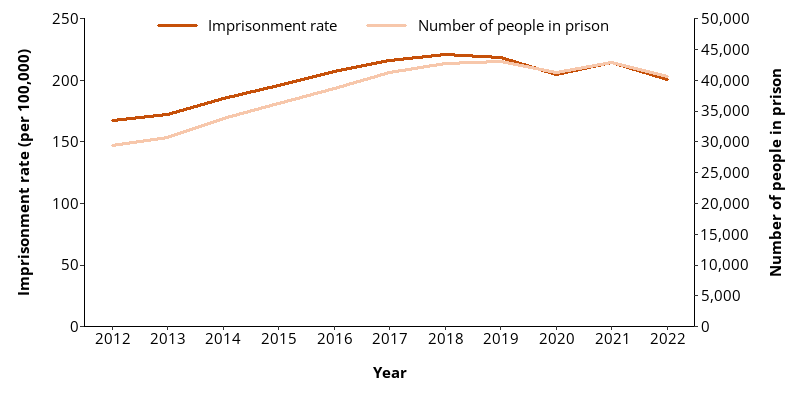How many people are in prison in Australia?
The number of people in Australia’s prisons grew from almost 29,400 in 2012 to around 40,600 in 2022 – an increase of around 38% (ABS 2023). The general Australian population increased by 15% over the same period (ABS 2022a). The imprisonment rate of people in Australia per 100,000 adults in the general population rose from 167 on 30 June 2012 to 201 on 30 June 2022 (Figure 1.1) (ABS 2023).
Figure 1.1: Number of people in prison and imprisonment rate in Australia, by year, 2012–22

Note: The imprisonment rate is the number of people in prison per 100,000 adults, aged 18 and above, in Australia.
Source: ABS 2023, Table 2.
Many people enter and leave prison each year. People in prison may be either sentenced or unsentenced (on remand) while awaiting trial and sentencing.
In 2022, the imprisonment rate of males was 379 per 100,000 males in the general Australian adult population. The imprisonment rate of females was 29 per 100,000 females in the general Australian adult population (ABS 2023).
Aboriginal and Torres Strait Islander (referred to as First Nations in this report) males were imprisoned at a rate of 4,303 per 100,000 males in the First Nations adult population, 16 times the rate of non-Indigenous males in Australia. First Nations females were imprisoned at a rate of 412 per 100,000 females in the First Nations adult population, 23 times the rate of non-Indigenous females in the Australian adult population (ABS 2023). First Nations people account for 3.2% of the Australian population but for 32% of Australia’s incarcerated population (ABS 2022b, 2023).
It is important to understand how the past shapes the lives of First Nations people today: they have a long history of trauma, cultural dispossession, and forced displacement and assimilation, which affects their physical, mental and social wellbeing.
Disconnection from family and kinship systems, from Country, from spirituality and cultural practices – as well as the loss of parenting practices – are sources of trauma that can be passed from caregiver to child. First Nations Australians’ experience of child welfare policies has historically been traumatic, with the policy of forcible removal of children leading to what is now known as the Stolen Generations. These removal policies have long-term consequences, including enduring social, physical and psychological impacts for those directly involved and their families and communities. The over-representation of First Nations people in prisons reflects this history of trauma and the stressors that have affected these people’s parents, families and communities.
ABS (Australian Bureau of Statistics) (2022a) National, state and territory population, ABS website, accessed 1 August 2023.
—— (2022b) Census of Population and Housing – counts of Aboriginal and Torres Strait Islander Australians, ABS website, accessed 18 July 2023.
—— (2023) Prisoners in Australia, 2022, ABS website, accessed 2 June 2023.


